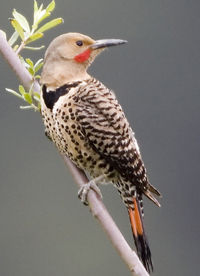
Introduction
In an attempt to replenish wildlife populations that have been dissolving do to human development, the United Indian Health Services' Potawot Health Village has put much effort into creating suitable habitats for many animal species. To do this, many topographical changes have been made to the land. Once just flat land, Potawot health village has been transformed into an area with various flat pastures, berms, islands, orchards, and wetlands.
Indicator Species
In an attempt to monitor the wildlife populations, the United Indian Health Services (UIHS) uses birds as indicator species, more easily monitored species who can, by their numbers, help us understand what other animals directly related to the indicator species. For example, by noticing increases in raptors, such as Kites, one can induce that the population of shrews, an important prey of the raptor, must be increasing. Another example might be the increasing number of woodpeckers, such as the northern flicker, which indicates increasing health among insect populations.
Efforts
The UIHS has done many efforts at Potawot to increase animal populations. Some of these efforts include creating environments that mimic the natural environments of wanted species, such as wetland, meadow, grassland, and upland environments. In the wetland environments, ponds are created with increasing depth towards the center of the pond (see figure 1). This allows for grasses to grow along the edges, water plants to grow along the more shallow water within the pond, and deeper water in the center too deep for plants to grow. The deeper water allows for water fowl to land in the middle. Another example of progress done towards wildlife restoration is the emplacement of six bat boxes on the premises. These bat boxes have seen frequent use, and are effective in restoration of local bat population. Also, the ponds within the grounds of Potawot have been populated with three spined stickleback, which have been effective in lowering mosquito populations. Also, woody debris has been put in place around the ponds, this allows for a habitat in which longtail weasels, which have seen significant growth in numbers.